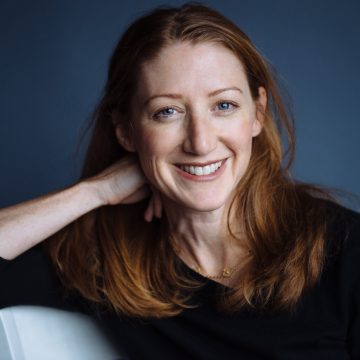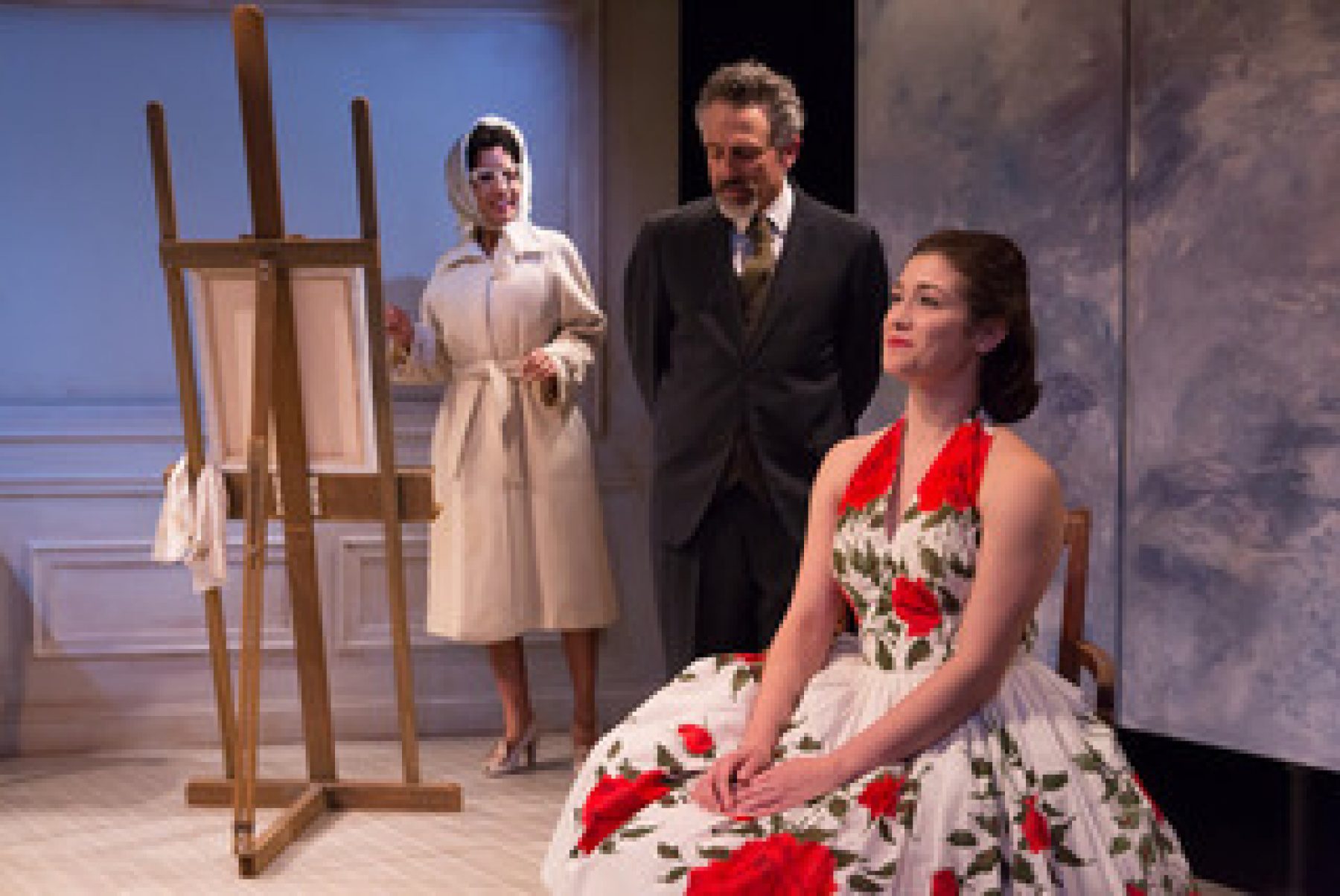
Scene from Professor Brenner. From left to right: Robyn Kerr, David Greenspan, and Makaela Shealy. Venue: HERE Arts Centre.
An Interview with Ellen Perecman
Alyssa Quint
In the following interview, DYTP contributing editor Alyssa Quint speaks with Ellen Perecman about her new collection of translations, Ten Yiddish Plays in Translation (Iuniverse, 2020). The translations were based on a decade’s worth of plays that Perecman and her New Worlds Theatre Project produced in New York City from 2005–2016.
Alyssa Quint: When did you begin translating this collection of plays?
Ellen Perecman: I began translating the first of them almost 16 years ago, when I founded my theatre company, New Worlds Theatre Project (NWTP). The first play was Carcass (Di neveyle) by Peretz Hirshbeyn. In retrospect, that first production was a trial run. It was my first project as a theatre producer. I had had professional theatre training as an actor, but I didn’t know the first thing about producing! As the years went on, I learned how to be a producer. NWTP began winning grants and amassing donations. With money in the bank, we had the financial resources to hire professional theatre artists and technical crews and to rent venues where I wouldn’t have to scrub the bathrooms clean myself! At that point, I knew I had “made it.”
My first draft of a translation is pretty much literal. I then go back and work on the script until it sounds like English and not like a translation from another language. A good translation gets revised over and over again until it feels just right. Eventually, I have a draft to show the director, who makes his/her own revisions. These are typically line cuts that make the story flow better. And there are usually more revisions as the director and I listen to the play in rehearsal. An actor might request a change in her line. She’ll ask “Do you mind if I say this instead of this?” This might be because the sequence of words in a line is hard to pronounce fluently, or simply because the actor thinks his line is better. At that point, I consult my binder that includes the original Yiddish on one page and the English translation on the facing page. If I think the change is consistent with the original Yiddish text, I will tell the director and then the decision is up to him.
In the case of Carcass, because it was my first script, I continued making revisions—I would say improvements—over the years until, in 2013, I was very happy with the script and decided to mount another production of the play. The second production of Carcass was magnificent, if I say so myself… The New York Times wrote about the production something like “it’s hard to watch but it’s hard to look away.”
[For this volume], the process of revision took a lot longer: after NWTP closed its doors—so to speak—I went back and reread all the English scripts against the original Yiddish texts. In some cases, I found chunks of a play missing and had to decide whether to include them in the English script. In some cases, the translation was just wrong. And, in other cases, I didn’t think the translation was the best I could do for a given line.
AQ: How did you begin producing Yiddish theatre?
EP: I had gone to see Zalmen Mlotek to try to convince him that it would be a good idea for the Folksbiene to start doing some plays in English translation. My argument was that he and other Yiddish theatre folks had an obligation to bring Yiddish plays that were written when Yiddish was alive in the streets of Eastern Europe to the attention of wider audiences, and the larger theatre world. I argued that the Folksbiene’s audiences should be able to follow the storyline in the play. That they should hear what the playwright is trying to tell them. Instead, the vast majority of their audiences were coming to hear the sound of Yiddish but came away with only a vague idea—if that—of what the playwright was trying to tell them. Zalmen said the board would never go for it, so, I decided I would do it myself. What is the point of seeing a Yiddish play if you can’t understand what’s being said? To feel nostalgia? For sentimental reasons? But that’s not why the playwright wrote the play. The playwright had something he/she wanted to say. And there are quite a few Yiddish plays that still speak powerfully to audiences today. There’s no reason why the non-Yiddish speaking world shouldn’t have access to them.
AQ: How did you go about selecting the plays you wanted to translate?
EP: In the first couple of years, I had a partner in NWTP, Mark Altman, who had previously worked at the Folksbiene. He agreed with me that Yiddish plays should be offered in English translation. But, more importantly, he could read Yiddish fluently. For me, on the other hand, reading Yiddish was still a chore back then. My grandfather had taught me how to read a few Yiddish words in the Forward newspaper when I was a child. But that was the extent of my Yiddish reading skills. Since Yiddish is my first language, my aural skills were just fine.
Mark and I had a very efficient process. Mark would sit on my couch and read the play to me in Yiddish, as I automatically translated what he read into English and typed the translation into my laptop. Once I was on my own—after Mark’s departure, I simply read as many plays as I could and chose those: 1) that I liked; 2) that are well written; 3) that have a dramatic arc; and 4) whose themes are relevant for contemporary audiences. This was not as easy as it sounds. I remember sitting in the garden of a friend’s house in the south of France one summer reading play after play after play in a volume of one playwright’s plays. None of them met my criteria. And then, finally, I read one that I could imagine doing.
It was Mark who suggested that Carcass be our first play. He thought that what Hirshbeyn did in that play would send a clear message that NWTP was not your standard issue Yiddish theatre. And Mark was absolutely right. After a performance in our first run of Carcass, one audience member stopped on his way out to berate me for “showing something like this in public.”
I must add that my father, (he passed away four years ago) was also a shtikl (little) collaborator on the translations. He was a watchmaker who considered watchmaking his hobby. I spent long weekends with him during the few years before he died. I would sit next to him at the same kitchen table working on my translations. And when I couldn’t find a word in any of my dictionaries, I would ask him: “Do you do know what this means?” Often, he knew. And when he didn’t, he would say: ”I never heard of that word. That can’t be right!” That was my father.
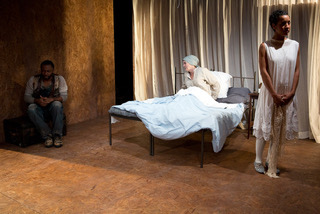
Scene from Carcass. Left to right: Alvin Keith, Kathryn Rossetter, and Robyn Kerr. Venue: HERE Arts Centre.
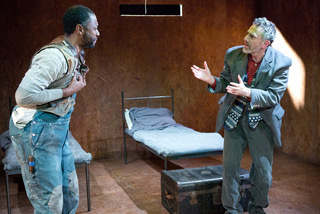
Scene from Carcass. Left: Alvin Keith. Right: David Greenspan. Venue: HERE Arts Centre.
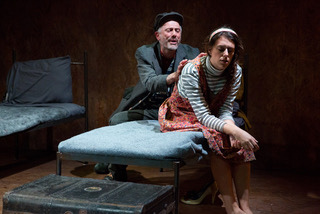
Scene from Carcass. Left: David Greenspan. Right: Rebekah Levin. Venue: HERE Arts Centre.
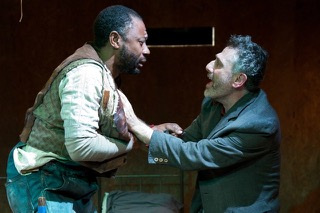
Scene from Carcass. Left: Alvin Keith. Right: David Greenspan. Venue: HERE Arts Centre.
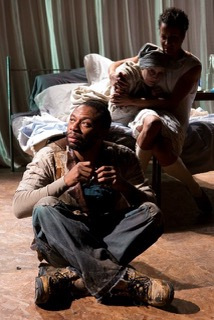
Scene from Carcass. Left to right: Alvin Keith, Kathryn Rossetter, and Robyn Kerr. Venue: HERE Arts Centre.
AQ: You were doing this primarily for the stage.
EP: Totally. If you take a look at the cover of the book [a contemporary photograph of a stage and a large stage light], I think it’s clear who my primary audience is: it’s the theatre community.
AQ: I guess that means your target audience is wider than the Jewish or Yiddish-speaking community.
EP: Absolutely. These plays were chosen because I believe that their themes are as relevant to contemporary audiences today as they were to early twentieth century audiences. I chose plays that I was confident audiences would be able to read themselves into, whatever their cultural background. Let me give you an example of what I mean: after a performance of Welcome to America, which is a shortened version of Shmates (Rags) by H. Leivick, an audience member of South Asian descent told me how much he enjoyed the play because, since he came from an immigrant family himself, he could completely relate to the play.
Another example is Sholem Aleichem’s Mentshn (lit. people): the play has a lot of funny lines, but it is also a critique of the privileged class of Jews who relied on servants to run their homes.
In production, we tried to magnify the relatability and resonance with today. In our production of Berkovitz’s Under the Cross (Moshke Khazer; Untern tseylem, 1923), I decided to cast African American actors in the roles of the Jewish characters in the play because the play revolves around a pogrom against Jews in Russia, broadly put, a form of discrimination. Moshke Khazer’s character is a Jewish man who converted to Christianity. He was played by an African-American actor, as was Yakov, Moshke’s son by his Christian wife. The casting was particularly poignant in the case of Yakov, because he participates in the pogrom against the Jews. The roles of the Christian Russians are played by white actors. And, in fact, there is a scene in the play where a white Christian Russian pulls out a gun on Rokhl.
AQ: Did you have a company of actors and technical crew that you worked with?
EP: Well, we didn’t have a company per se. But we did use some of the same people over and over again. David Greenspan, a six-time Obie award-winning actor, performed in three of the plays. Alvin Keith, another fine actor (Broadway revival of Cat on a Hot Tin Roof) and many regional theaters, performed in four of our shows. Marc Geller directed three plays for NWTP; Paul Takacs directed two. The technical crew varied, though we worked with set designers Bill Clarke and Steven Kemp on multiple shows.
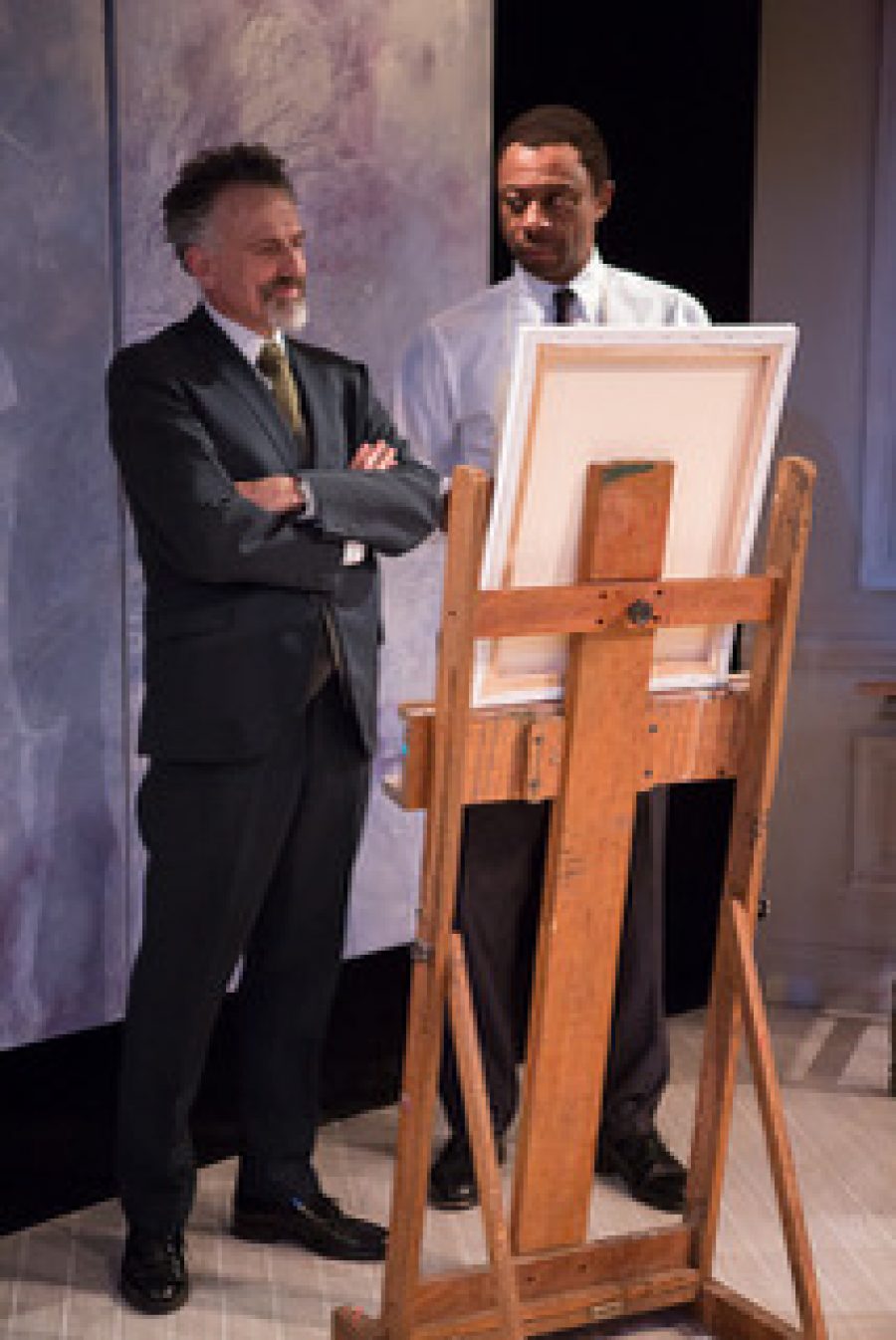
Scene from Professor Brenner. Left: David Greenspan. Right: Alvin Keith. Venue: HERE Arts Centre.
AQ: What plays evolved the most over the years you spent revising their translations?
EP: Well, Mark and I presented On the Other Side of the River (Af yener zayt taykh) by Peretz Hirshbeyn under the title The Amulet in 2006 because the story revolves around an amulet, and we thought it was a catchier title. As I described earlier, Mark read the Yiddish to me and I typed the English translation into my laptop. Well, it seems the Yiddish text Mark was reading was not, in fact, Hirshbeyn’s original text. When I read the actual original text years later, I discovered a very different ending to the play. The text Mark was reading to me ends with Mirl drowning herself in the river, having never again seen the Stranger. Hirshbeyn actually ends the play with a stage direction that reads: “On the other side of the river, the STRANGER appears in a pale light.” A very different ending.
The second play for which the English script in this volume differs dramatically from the script we used when we produced the play is Mentshn by Sholem Aleichem. In this case I have to assume that Mark didn’t think we should include the silly humor in the play, that it would detract from the serious story. When I read the play on my own in preparation for issuing my recent book, I discovered the wealth of silly humor and added it back into the English script.
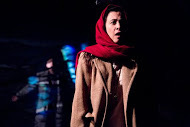
Scene from On the Other Side of the River. Left: David Greenspan. Right: Jane Cortney. Venue: HERE Arts Centre.
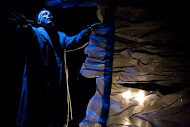
Scene from On the Other Side of the River. David Greenspan. Venue: HERE Arts Centre.
AQ: Describe what you decided to do with A Wedding in Ferenvald (A khasene in Ferenvald, 1947-49), H. Leivick’s play/poem about a group of Holocaust survivors in a Displaced Persons’ camp in Föhrenwald, Germany. This is the least literal of your translations. And you renamed it Displaced Wedding calling it an adaptation.
EP: There are actually three plays in the book that I refer to as adaptations of Yiddish works: With the Current, Welcome to America, and Displaced Wedding.
The English script for With the Current (Mitn shtrom) includes the English translation of Hebrew prayers and also repetitions of these prayers in Hebrew. One could conceivably call that an adaptation of the Yiddish script. Welcome to America includes only two acts, as opposed to the three acts of the original Yiddish play, Shmates, and creates lines for the actors that provide the information in the original Act 2. Definitely an adaptation.
Displaced Wedding is an adaptation in that some of the Holocaust survivor characters in the original Yiddish play become survivors of other genocides. This expansion of the play is suggested by lines in one of Elijahu’s speeches. He says: “I warn you: mankind is destroying itself. Obsessed with conceiving ever more atrocious techniques for committing genocide.”
In the original Yiddish, the prologue to Displaced Wedding is spoken by a single narrator. In the English adaptation, each of the lines of the prologue is spoken by a different actor/character, and lines were inserted to refer to the other genocides. The final piece of adaptation is the inclusion of actual survivor testimonies in the body of the play.
When I started reading actual testimonies of survivors of other genocides, I was struck by how similar they were to testimonies of Holocaust survivors. The inclusion of these testimonies also gave me the opportunity to provide details of how members of my own family survived the Holocaust. I see this play as a tribute to all of them.
AQ: In this volume you are trying to make them broadly culturally available. You encourage people to perform them and—through these plays, which were written over a hundred years ago in a language few people speak—to engage with their own world and issues, that is with the contemporary world.
Absolutely. It has always been my goal to create a script that would be experienced—heard and thought about—in a way comparable to how people reading or seeing the play 100 years ago would have experienced it. As relevant to their world and their lives.
AQ: What was one of the greatest surprises you met with in translating these plays?
EP: I was also surprised by the reaction on the part of some members of the audience to very early translations, where I included Yiddish words or retained a reference to a Jewish cultural practice. For example, in Carcass, Berl asks Avrush, (literally): “How many times did you make kiddish today?” [AQ: Meaning, how much alcohol did you consume today?]. In the first draft of the Carcass English script, I included this literal translation of the Yiddish line. But a friend told me that hearing Yiddish in the middle of English dialogue took him out of the world of the play for that moment, it was a distraction. So, in the second production of Carcass, I changed Berl’s line to Avrush to read: “How much did you have to drink today?” Which is what he means anyway.
